
The Saint Thomas Christians, also called Syrian Christians of India, Marthoma Suriyani Nasrani, Malankara Nasrani, or Nasrani Mappila, are an ethno-religious community of Indian Christians in the state of Kerala, who, for the most part, employ the Eastern and Western liturgical rites of Syriac Christianity. They trace their origins to the evangelistic activity of Thomas the Apostle in the 1st century. The Saint Thomas Christians had been historically a part of the hierarchy of the Church of the East but are now divided into several different Eastern Catholic, Oriental Orthodox, Protestant, and independent bodies, each with their own liturgies and traditions. They are Malayalis and their mother tongue is Malayalam. Nasrani or Nazarene is a Syriac term for Christians, who were among the first converts to Christianity in the Near East.

The Syro-Malankara Catholic Church, also known as the Malankara Syrian Catholic Church, is an Eastern Catholic sui iuris particular church in full communion with the worldwide Catholic Church possessing self-governance under the Code of Canons of the Eastern Churches. It is one of the major archiepiscopal churches of the Catholic Church. It is headed by Major Archbishop Baselios Cardinal Cleemis Catholicos of the Major Archdiocese of Trivandrum based in Kerala, India. With more than 1096 parishes, it is one of India's biggest church evangelical establishments.

The Syro-Malabar Church, also known as the Syro-Malabar Catholic Church, is an Eastern Catholic church based in Kerala, India. It is a sui iuris (autonomous) particular church in full communion with the Holy See and the worldwide Catholic Church, with self-governance under the Code of Canons of the Eastern Churches (CCEO). The major archbishop presides over the entire church. The incumbent Major Archbishop is Raphael Thattil, serving since January 2024. It is the largest Syriac Christian church and the largest Eastern Catholic church. Syro-Malabar is a prefix reflecting the church's use of the East Syriac liturgy and origins in Malabar. The name has been in usage in official Vatican documents since the nineteenth century.

The Synod of Diamper (Udayamperoor Synod) (Malayalam: ഉദയംപേരൂർ സൂനഹദോസ്, romanized: Udayampērūṟ Sūnahadōs), held at Udayamperoor (known as Diamper in non-vernacular sources) in June 1599, was a diocesan synod, or council, that created rules and regulations for the ancient Saint Thomas Christians (also known as Mar Thoma Nasranis) of the Malabar Coast, a part of modern-day Kerala state, India, formally subjugating them and downgrading their whole Metropolitanate of India as the Diocese of Angamale, a suffragan see to the Archdiocese of Goa administered by Latin Church Padroado missionaries. This synod also introduced forced Liturgical Latinisation and the eschewal of local practices and beliefs, leading to a significant ecclesial protest by Saint Thomas Christians known as Coonan Cross Oath and a subsequent schism in the mid-17th century.

The Coonan Cross Oath, also known as the Great Oath of Bent Cross or Leaning Cross Oath, was taken on 3 January 1653, in Mattancherry, by a significant portion of the Saint Thomas Christian community in the Malabar region of India. This public declaration marked their refusal to submit to the authority of the Jesuits and the Latin Catholic hierarchy, as well as their rejection of Portuguese dominance in both ecclesiastical and secular matters.

The Eparchy of Irinjalakuda is a suffragan eparchy in the ecclesiastical province of the metropolitan Syro-Malabar Catholic Archeparchy of Thrissur in Kerala state's Thrissur District, southern India.It is part of the Syro-Malabar Church.

This is a timeline of the history of the Syro-Malabar Catholic Church in India.

The Malankara Church, also known as Puthenkur, is the unified body of Saint Thomas Christians using the West Syriac Rite who claim origins from the missions of Thomas the Apostle. This community, under the leadership of Thoma I, opposed the Padroado Jesuits as well as the Propaganda Carmelites following the Coonan Cross Oath of 1653, which was taken to resist Western Catholic influences.

Paremmakkal Thoma Kathanar (1736–1799) is the author of Varthamanappusthakam (1790), the first ever travelogue in an Indian language. Also known as Roma Yatraa Varthamanapusthakam, it postulates that the foundation of Indian nationalism rests on the basic principle that India should achieve civic self-rule. Long before the debates on nationalism shaking the intellectual circles of Europe, Asia, and Africa, Thoma Kathanar offers a distinctive positionality as a minority Syriac Christian priest and subsequent administrator of the Archdiocese of Cranganore with transnational ties to Portuguese ecclesiology who nevertheless argues in favor of autonomous civic Indian governance.

Parambil Chandy was an Indian Catholic prelate who served as Archbishop of Cranganore from 1663 to 1687. He was the first known native Indian bishop.

St. Thomas Cathedral is the Syro Malabar Catholic cathedral of the eparchy of Irinjalakuda in India. It presently exists under the nomenclature and the Canonical Status as Cathedral in the Wake of the Origin of the New Eparchy, effected by the amalgamation of the two independent and important parishes of the locality, namely, St. George’s Forane Church and St. Mary’s church, which were amicably situated side by side for about a century.

The Saint Thomas Christian denominations are Christian denominations from Kerala, India, which traditionally trace their ultimate origins to the evangelistic activity of Thomas the Apostle in the 1st century. They are also known as "Nasranis" as well. The Syriac term "Nasrani" is still used by St. Thomas Christians in Kerala. It is part of the Eastern Christianity institution.
Varthamanappusthakam is a Malayalam travelogue written by Paremmakkal Thoma Kathanar, a Nasrani Mappila kathanar of the modern-day Syro-Malabar Church. It is the first ever travelogue written in an Indian Language. It was written in the 18th century (1790) but then forgotten, being re-discovered in 1935 and first printed in 1936 by Luka Mathai Plathottam at Athirampuzha St Marys Press in the year 1936.

Mar Hormizd Cathedral, locally known as the Eastern Church of Angamaly or the Cathedral Church, is a Syro-Malabar church in Angamaly, India. It was created cathedral in 1577 by Mar Abraham, the last East Syriac Metropolitan to reach Malabar Coast. It is one of the oldest and is historically the most important of the three ancient Syrian churches in Angamaly. It is dedicated to Mar Hormizd, a seventh-century East Syriac saint.

St. Mary's Jacobite Syrian Soonoro Cathedral, or Angamaly Cheriyapally, is an ancient Jacobite Syrian church located in Angamaly. Founded in 1564 by Archdeacon Giwargis of Christ, it is one of the most prominent and ancient Syriac Orthodox churches in Kerala. In the seventeenth century it was the residence of Archdeacon Thomas Parambil, who eventually got consecrated as bishop Mar Thoma I following the Coonan Cross Oath in 1653. It was initially the seat of the Archdeacon and later the Marthoma methrans, the local heads of the Malankara Church and hence held an important position in the church for several centuries.

The Archdiocese of Cranganore or Cranganor and Angamaly was a latinised Syriac Padroado Archdiocese in Kodungallur, Kerala, India. This diocese is a product of so-called Synod of Diamper held in Chaldean Catholic Archdiocese of Angamaly and All India. Its headquarters was first at St. Thomas church, Cranganore Fort until 1662 and then at Puthenchira church for more than a century. Mar Paremmakkal Thoma Kathanar, Administrator of the diocese moved its headquarters to Vadayar due to invasion of Tipu Sultan. Mar Poulose Pandari, a Chaldean Bishop belongs to Puthenchira parish of this diocese.

Kadavil Chandy Kathanar, also known as Alexander the Indian was a Kathanar (priest) and a celebrated scholar, orator, hymnographer and syriacist from the Saint Thomas Christian community in India. He was a prominent face of the Saint Thomas Christians and lead their Catholic faction during a turbulent period of divisions in the community after the Coonan Cross Oath of 1653. He was from Kaduthuruthy, Kottayam in Kerala state of India. He often reacted vehemently against the colonial Padroado latin subjugation over his community and resisted their ecclesiastical and cultural dominance. He was widely reputed for his knowledge in Syriac language and literature, and was often praised, both among his own community and the European missionaries who wrote about him in their letters addressed to the Portuguese monarch and to the Pope. His acrostic poems propagated even among West Asia's Syriac-speaking communities. Although he stood against the Latin colonialists, he commanded respect from the Portuguese and the local Hindu kings alike.
Angamāly Padiyōla is a historic declaration of the Syrian Catholic/ Syro Malabar (Paḻayakūṟ) Saint Thomas Christians proclaimed in 1787 at the Great Church of Saint George in Angamāly. This document made a strong appeal to the pope for the consecration of a native bishop for the community and demanded autonomy for their Church which was forcibly brought under the Latin Church's jurisdiction.

The Paḻayakūṟ, also known as Romo-Syrians or Syrian Catholics of Malabar, are the Saint Thomas Christians who use the East Syriac Rite and claim apostolic origin from the Indian mission of Thomas the Apostle in the 1st century AD.
















